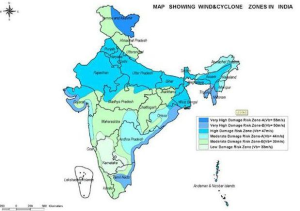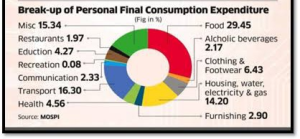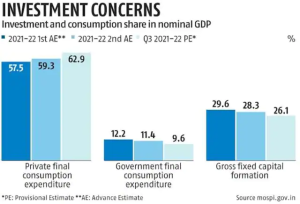Prelims – 15th Nov 23
Cyclones
A cyclone can be defined as “a system of winds that are rotating inwards to an area of low barometric pressure, such that in the Northern Hemisphere it is anticlockwise and in the Southern Hemisphere it is clockwise circulation”.
How are Cyclones Formed?
There are 6 factors that can be held responsible for the formation of the cyclone:
- Ample amount of warm temperature at the surface of the sea.
- Instability in the atmosphere.
- How the Coriolis force is impacting the area so that low-pressure area can be created.
- When the humidity is high in the lower to middle levels of the troposphere.
- Disturbance in the pre-existing low-level area.
- When the vertical wind shear is low.
India’s vulnerability to cyclones:
- Out of 7516 Km of Indian coasts line 5770 Km (76.76%) are highly vulnerable to Cyclones.
- Most of the cyclones generated in the South Asia are from Bay of Bengal and Indian Ocean.
- Indian region inhabits 7 % of the total tropical cyclones of the world.

The Private final consumption expenditure (PFCE)
It is defined as the expenditure incurred by the resident households and non-profit institutions serving households (NPISH) on final consumption of goods and services, whether made within or outside the economic territory.
Personal consumption has long been the main component of India’s GDP and a continued strong engine of GDP growth.


Private Final Consumption Expenditure (PFCE) is most important components of India’s GDP:
- It is a general consensus that the economic growth in developing countries is necessarily consumption-led instead of production/investment-led. Therefore, PFCE is important for India’s GDP.
- In India, the PFCE accounts for 55-56% of all national GDP in a year and is the biggest driver of economic growth.
- PFCE also indirectly influences the next biggest driver of GDP — the Gross Fixed Capital Formation (GFCF). This is a measure of the money spent by businesses when they make investments, and it accounts for 33% of all GDP.
- If consumer demand slows down, it robs businesses of any incentive to boost productive capacities by making fresh investments. Just boosting investments—without regard for demand—will not make sense.
- The weighty role of private consumer demand in boosting the GDP makes it the most important factor determining India’s economic fortunes.
VAIBHAV Scheme
Ministry: Ministry of Science and Technology
Aim:
- to facilitate collaboration between the Indian diaspora in Science, Technology, Engineering, Mathematics and Medicine (STEMM) and Indian academic and research institutions.
- improving the research ecosystem of India’s Higher Educational and Scientific Institutions.
More info
- It will have 18 identified knowledge verticals
- Open to scientists and technologists of Indian origin.
